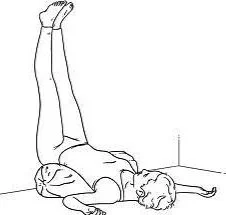Legs up the wall
Viparita Karani
Legs up the wall pose
Before performing the pose, determine two things about your support: its height and its distance from the wall. If you’re stiffer, the support should be lower and placed farther from the wall; if you’re more flexible, use a higher support that is closer to the wall. Your distance from the wall also depends on your height: if you’re shorter move closer to the wall, if taller move farther from the wall. Experiment with the position of your support until you find the placement that works for you. Flexible individuals might be okay with no support at all.
If you need support, start with your support about 5 to 6 inches away from the wall. Sit sideways on right end of the support, with your right side against the wall (left-handers can substitute “left” for “right” in these instructions). Exhale and, with one smooth movement, swing your legs up onto the wall and your shoulders and head lightly down onto the floor.
Modifications & Variations
It’s not necessary for your sit bones to touch the wall. However, you should be in a position where you can release the need to “hold up” your thigh bones. Those with more flexible bodies can use a higher support or move closer to the wall; those with stiffer bodies should try a lower support or move further away from the wall. Try various heights of support and placements against the wall to determine the most comfortable and supported position for your body.
For greater support under your neck, place a small, rolled towel beneath the back of your neck.
For an added stretch to your thighs, hips, and groins, spread your legs wide into a “V” shape.
For a deeper release to your groins and hips, bend your knees and place the soles of your feet together. Let the outer edges of your feet slide down the wall, bringing your heels in toward your pelvis.
Tips :Viparita Karani is a “feel-good” pose — that is, it should feel good, even for beginners! If you have any discomfort, be sure to make whatever adjustments you need . Keep the following information in mind when practicing this pose: Breathe consciously throughout the pose. Continually bringing your awareness back to your breath will help relax your mind and body even further, preparing your body for a deep, renewing state of health and well-being.It might feel awkward getting into the pose the first few times you try it. Don’t worry about that, and take your time getting there correctly. Once you’re in the pose, you will gain all the benefits!

